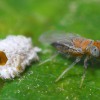 Anagyrus pseudococci is an economically important biological control agent commonly used against the vine mealybug (which infests wine grapes) and the citrus mealybug. It is a solitary, internal parasitoid and lays one egg per host, with the larva developing inside the host’s body. The wasps may be commercially reared and distributed inside mummies, and they will emerge within 1-5 days after delivery. Application involves placing a bottle containing the mummies in a dry spot of the crop and allowing the adults to emerge. This 5-page fact sheet was written by Theresa Chormanski and Ronald D. Cave, and published by the UF Department of Entomology and Nematology, March 2015. (Photo: Kent M. Dane)
Anagyrus pseudococci is an economically important biological control agent commonly used against the vine mealybug (which infests wine grapes) and the citrus mealybug. It is a solitary, internal parasitoid and lays one egg per host, with the larva developing inside the host’s body. The wasps may be commercially reared and distributed inside mummies, and they will emerge within 1-5 days after delivery. Application involves placing a bottle containing the mummies in a dry spot of the crop and allowing the adults to emerge. This 5-page fact sheet was written by Theresa Chormanski and Ronald D. Cave, and published by the UF Department of Entomology and Nematology, March 2015. (Photo: Kent M. Dane)
http://edis.ifas.ufl.edu/in1081
Tag: Biological Control for Insect Management
Natural Enemies of Rugose Spiraling Whitefly, Aleurodicus rugioperculatus Martin (Insecta: Hemiptera: Aleyrodidae) in the South Florida Landscape
 Rugose spiraling whitefly was first observed in south Florida in 2009. It has been found in 17 counties in south and central Florida. This whitefly has been reported on more than 60 plant species, which include gumbo limbo, coconut, black olive, avocado, Calophyllum spp., and giant white bird of paradise. This 6-page fact sheet describes the predators and parasitoids found feeding on this whitefly in the south Florida landscape. Written by Siavash Taravati, Catharine Mannion and Holly Glenn, and published by the UF Department of Entomology and Nematology, August 2013.
Rugose spiraling whitefly was first observed in south Florida in 2009. It has been found in 17 counties in south and central Florida. This whitefly has been reported on more than 60 plant species, which include gumbo limbo, coconut, black olive, avocado, Calophyllum spp., and giant white bird of paradise. This 6-page fact sheet describes the predators and parasitoids found feeding on this whitefly in the south Florida landscape. Written by Siavash Taravati, Catharine Mannion and Holly Glenn, and published by the UF Department of Entomology and Nematology, August 2013.
http://edis.ifas.ufl.edu/in1004